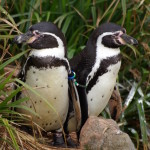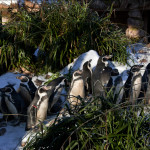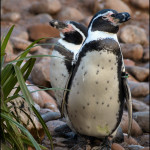Fun Facts
Characteristics
- They have to groom their feathers often to keep them waterproof and in good condition.
- They are very agile swimmers, as they are hunted by many animals and this is their only method of escape.
- They have long claws to climb with.
- Unlike many birds, they have solid bones. These are used to keep them balanced in the water.
- Experiments suggest that they can recognise the smell of their relatives and familiar penguins.
Humboldt Penguins
Spheniscus humboldti
Animals — Aves (birds) — Sphenisciformes (penguins)
Humboldt penguins are medium sized penguins named after the current they swim in. The current is cold water and can support many fish.
Classified as “Vulnerable” by the IUCN, these penguins have historically been affected by guano production reducing nest sites. More pressing concerns currently are over-fishing (reducing food sources for the penguins), climate change, ocean acidification and invasive species that may eat their eggs and young.
Habitat: Coastal and island areas. They live in burrows in soil or rock or crevices in rocks, but spend most of their time at sea.
Vital Statistics:
–Average weight: 4kg
–Average height: 41cm
Life Expectancy:
In the wild up to: 20 years
In captivity up to: 30 years
Diet: Meat eater. Eat fish and crustaceans.
Distribution: Coasts of Peru and Chile.
Conservation: Our related conservation charity is the APCPP- Association for Protection of Condors and Penguins of Peru. This project is based in north west Peru, where our rangers patrol the beaches to reduce pollution and poaching. We also work on reforesting the landscape, and work in collaboration with scientific research projects in the area. This project also works with fishing companies to ensure they rotate their fishing areas, preventing over-fishing and increasing food sources.






